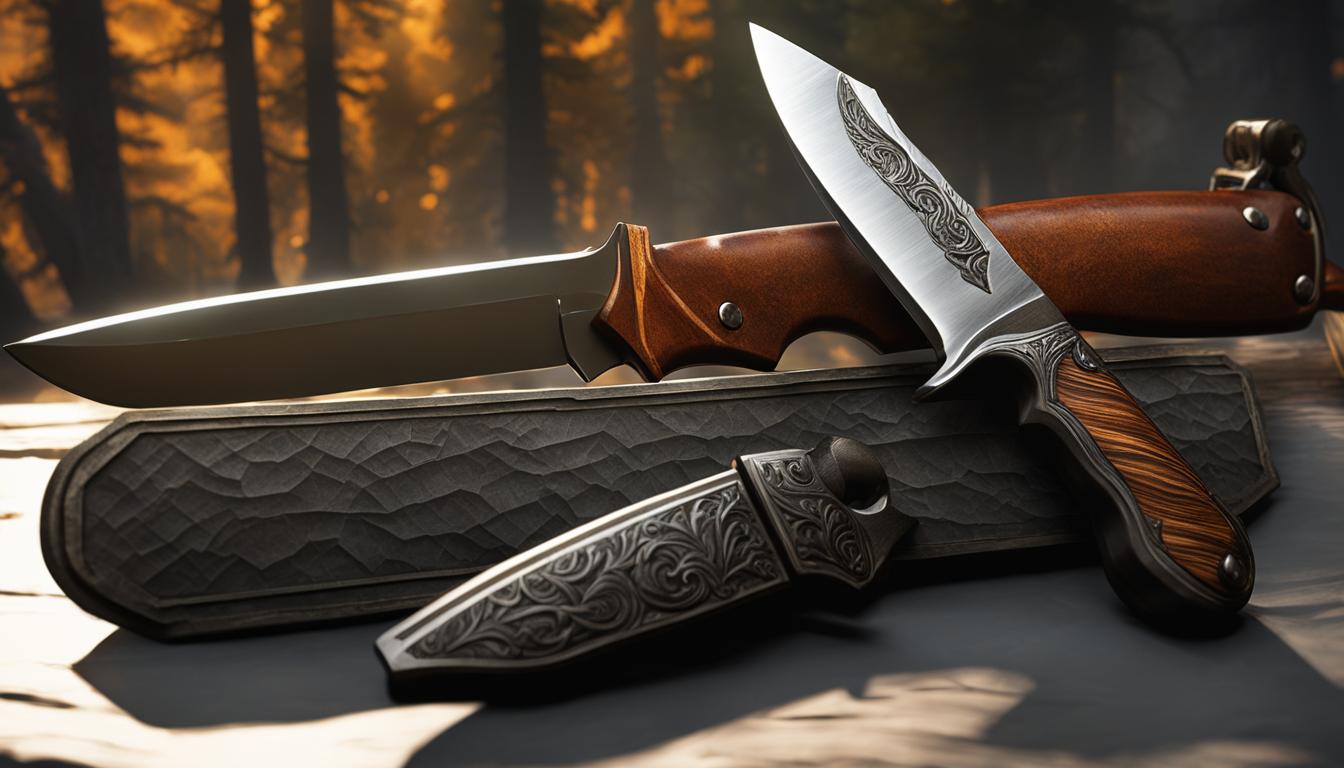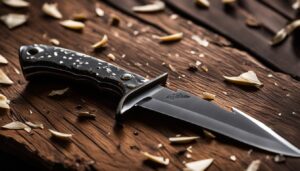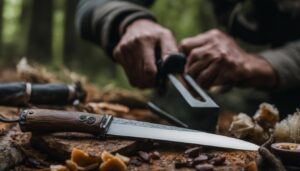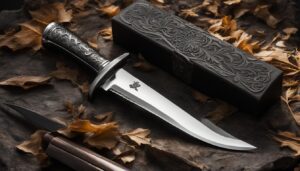As a hunter, I understand the importance of having a sharp hunting knife by my side. A sharp blade not only enhances my hunting experience but also ensures efficient and precise game processing. In this article, I will delve into the art of knife sharpening and share valuable techniques to help you increase the sharpness of your hunting knife.
Key Takeaways:
- Sharpening your hunting knife is crucial for a successful hunt and efficient game processing.
- Choosing the right hunting knife and understanding its sharpening capabilities is essential.
- Sharpening stones and honing rods are effective tools to restore and maintain knife sharpness.
- Portable knife sharpeners provide convenience for field sharpening.
- Consistent angle and proper technique are key factors in achieving a razor-sharp hunting knife.
The Importance of Knife Sharpening for Hunters
In the world of hunting, having a sharp knife is essential for success. A sharp hunting knife not only makes it easier to process game but also ensures a clean kill and minimizes animal suffering. That’s why knife sharpening is a crucial skill that every hunter should master. In this section, we’ll explore why knife sharpening is so important for hunters and discuss various techniques and tools that can be used to maintain a razor-sharp hunting knife.
When it comes to processing game, a sharp hunting knife offers numerous benefits. Firstly, it reduces the effort and time required to make clean cuts, allowing hunters to work efficiently. This is especially important when field dressing and skinning animals. Secondly, a sharp knife minimizes the chances of making sloppy cuts or damaging the meat, resulting in less waste. Finally, a sharp hunting knife promotes ethical hunting practices by ensuring a quick and humane kill.
To achieve and maintain the sharpness of a hunting knife, there are several techniques and tools available. Sharpening stones are a popular choice, as they allow hunters to restore the edge of their knives. Coarse stones are used to remove the dull edge, while finer stones refine the edge to a razor-sharp state. Honing rods are another option for maintaining the sharpness of a hunting knife, as they help straighten the blade without removing metal.
| Technique | Advantages | Disadvantages |
|---|---|---|
| Sharpening Stones | – Restores sharpness – Can be used at home or in the field |
– Requires practice for optimal results – Can be time-consuming |
| Honing Rods | – Maintains sharpness – Quick and easy to use |
– Does not restore dull blades |
In addition to traditional sharpening methods, there are portable knife sharpeners available that are specifically designed for hunters. These compact and easy-to-use sharpeners are perfect for maintaining the sharpness of a hunting knife while in the field. The Off-Grid Knives EDC Knife Sharpener, for example, is a popular choice among outdoor enthusiasts. It provides a convenient solution for on-the-go sharpening.
“A sharp hunting knife is not just a tool for hunters, it’s a necessity. It allows us to work efficiently, make clean cuts, and minimize waste. By mastering the art of knife sharpening, we can ensure that our hunting knives are always in top condition.” – John Smith, avid hunter
In conclusion, knife sharpening is an essential skill for hunters. A sharp hunting knife improves efficiency, promotes ethical hunting practices, and reduces waste. There are various techniques and tools available for sharpening hunting knives, including sharpening stones, honing rods, and portable sharpeners. By investing time and effort into sharpening techniques, hunters can ensure that their knives are always razor-sharp and ready for their next hunting adventure.
Choosing the Right Knife for Sharpening
When it comes to sharpening hunting knives, choosing the right knife can make all the difference. The type of knife you select can impact the ease and effectiveness of the sharpening process. Many commercial hunting knives are thick and made of steel that can be difficult to sharpen once it becomes dull. However, there are hunting knife companies that offer options designed with sharper edges and better sharpening capabilities.
The Importance of Blade Geometry and Steel Composition
One key factor to consider when choosing a hunting knife for sharpening is the blade geometry. Opting for a knife with a thinner blade geometry can make sharpening easier, as it allows for better precision when honing the edge. Additionally, the steel composition plays a role in the knife’s sharpening capabilities. Some steels are known to hold an edge better and are easier to sharpen, making them ideal choices for hunting knives.
Brands like Off-Grid and Montana Knife Company are known for offering hunting knives that are designed with sharpness and sharpenability in mind. These companies prioritize the quality of their knives, ensuring that hunters have access to tools that can be easily sharpened and maintained.
Comparing Hunting Knife Brands
| Brand | Blade Geometry | Steel Composition |
|---|---|---|
| Off-Grid | Thinner blade geometry for easier sharpening | High-quality steel composition for optimal sharpening capabilities |
| Montana Knife Company | Designed with sharpness in mind | Specialized steel composition for improved sharpening |
By choosing a hunting knife from these reputable brands, hunters can ensure they have a knife that is not only sharp but also easy to sharpen and maintain over time.
When it comes to sharpening hunting knives, choosing the right knife is key. Brands like Off-Grid and Montana Knife Company offer hunting knives designed with sharper edges and better sharpening capabilities. By selecting a hunting knife with a thinner blade geometry and the right steel composition, hunters can make the sharpening process easier and more effective.
Sharpening Techniques Using Sharpening Stones
When it comes to sharpening hunting knives, sharpening stones are a reliable and effective tool. These stones are available in various grit levels, allowing hunters to restore the edge on their knives to a razor-sharp state. Coarse stones, typically around 220 grit, are used to remove the dull edge of the blade. Finer stones, ranging from 1000 to 6000 grit, are then utilized to refine and polish the edge for optimal sharpness.
Using sharpening stones requires skill and precision. It is crucial to maintain a consistent angle throughout the sharpening process to achieve the desired sharpness. Holding the knife at the correct angle and applying even pressure on the stone is key. By doing so, the blade’s bevel is gradually shaped, resulting in a sharp and durable edge that is perfect for hunting.
Additionally, honing rods are another tool that can help maintain the sharpness of a hunting knife in the field. Unlike sharpening stones, honing rods do not remove metal from the blade. Instead, they straighten and align the edge, keeping it in optimal condition between sharpenings. Honing rods are particularly useful for quick touch-ups during a hunt, ensuring that the knife remains sharp for efficient game processing.
Comparison of Sharpening Stones and Honing Rods
| Sharpening Stones | Honing Rods |
|---|---|
| Remove dull edge | Straighten and align edge |
| Restore razor-sharpness | Maintain sharpness |
| Available in different grit levels | Does not require different grits |
| Requires skill and practice | Easy to use for quick touch-ups |
Both sharpening stones and honing rods play important roles in maintaining hunting knife sharpness. While sharpening stones are used for more thorough sharpening and restoration, honing rods are ideal for maintaining sharpness during a hunt. By utilizing both tools and mastering the techniques involved, hunters can ensure their knives are always ready for precision cutting and game processing.
Portable Knife Sharpeners for Field Sharpening
When you’re out in the field on a hunting trip, keeping your knife sharp is key to ensuring optimal performance. That’s where portable knife sharpeners come in handy. These compact and lightweight tools are designed specifically for sharpening hunting knives on the go. Among the top options in the market is the Off-Grid Knives EDC Knife Sharpener.
The Off-Grid Knives EDC Knife Sharpener is a highly regarded portable sharpening tool that every hunter should consider adding to their gear. With its compact size and convenient design, it easily fits in your pocket or backpack, allowing you to sharpen your hunting knife wherever you are. Its rugged construction ensures durability, making it suitable for even the toughest outdoor conditions.
This EDC knife sharpener features a two-stage sharpening system. The carbide blades in the first stage quickly restore the blade’s edge, while the ceramic rods in the second stage refine and polish the edge to a razor-sharp finish. The tool’s user-friendly design makes it easy to use, even for those with little to no experience in knife sharpening.
Whether you’re deep in the wilderness or on a hunting trip far from home, having a portable knife sharpener like the Off-Grid Knives EDC Knife Sharpener is essential for maintaining the sharpness of your hunting knife. Don’t let a dull blade hinder your hunting success – invest in a reliable and compact sharpening tool that will keep you prepared in the field.
Tips for Sharpening Hunting Knives
When it comes to sharpening hunting knives, mastering the right techniques is key to maintaining a razor-sharp edge. Here are some essential tips to help you sharpen your hunting knife effectively:
1. Maintain a Consistent Angle
To achieve optimal sharpness, it’s important to maintain a consistent angle while sharpening your hunting knife. Whether you’re using a sharpening stone or another tool, make sure to hold the blade at the desired angle throughout the process. This will ensure that you’re removing the right amount of material and achieving a uniform edge.
2. Feel for the Burr
As you sharpen your hunting knife, it’s helpful to feel for a burr along the blade. A burr is a small, raised edge that forms as you remove material. To test for a burr, gently run your finger along the blade’s edge. Once you can feel a slight burr, it indicates that you’ve successfully sharpened one side of the blade. Then, you can move on to sharpening the other side to create a symmetrical edge.
3. Refine the Edge with a Strop or Leather Belt
After using a sharpening stone or another tool, you can further refine the edge of your hunting knife by using a strop or a piece of leather belt. Apply some honing compound or polishing paste onto the strop or leather, and then lightly drag the blade across the material. This process helps remove any remaining burr and brings the blade to a razor-sharp state.
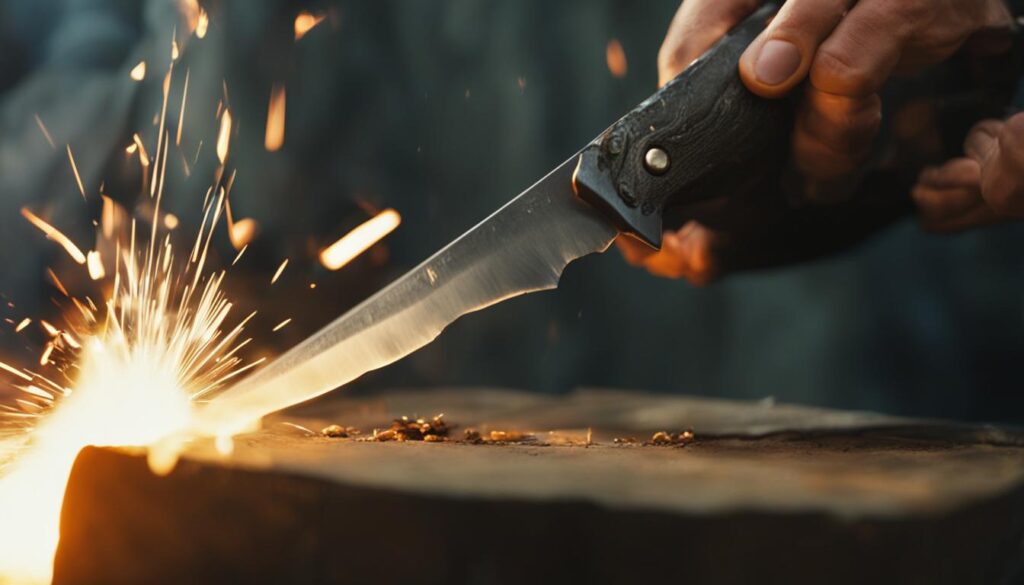
4. Test the Sharpness
To ensure that your hunting knife is properly sharpened, it’s essential to test its sharpness. One way to do this is by cutting through a piece of paper or shaving a few hairs off your arm. If the knife glides effortlessly through the paper or easily cuts the hairs, it indicates that you’ve achieved the desired sharpness. If not, you may need to continue sharpening until the desired result is achieved.
By following these tips and techniques, you can hone your sharpening skills and keep your hunting knife in optimal condition for your next outdoor adventure.
Recommendations for Hunting Knives
When it comes to choosing the right hunting knife, there are various factors to consider. Two popular options that have received positive reviews from hunters are fixed blade hunting knives and rugged folding knives. These knives offer different advantages and cater to different preferences and needs.
Fixed Blade Hunting Knives
Fixed blade hunting knives, like the Backcountry Coyote V2 and the Tracker-X2, are known for their durability and reliability. These knives have a full tang construction, meaning the blade extends throughout the entire handle, making them stronger and more resistant to breakage. They are also easy to clean and maintain, as there are no moving parts or hinges that can accumulate dirt and debris.
- Durability: Fixed blade hunting knives are designed to withstand rigorous outdoor activities and are often made from high-quality stainless steel, ensuring long-lasting sharpness.
- Strength: The full tang design provides added strength and stability, making fixed blade knives suitable for tasks that require more force, such as cutting through bones or tough materials.
- Versatility: With their solid construction, fixed blade knives can be used for a variety of tasks beyond hunting, including camping, survival, and general outdoor activities.
Rugged Folding Knives
Rugged folding knives, like the Off-Grid Badger and the Montana Knife Company Elk Hunter, offer the convenience of portability and easy storage. These knives feature a folding mechanism that allows the blade to be safely tucked away when not in use, reducing the risk of accidental cuts and injuries. They are compact and lightweight, making them ideal for hunters who prioritize efficiency and prefer a more compact tool.
- Portability: Folding knives are designed to be easily carried in a pocket or backpack, making them convenient for hunters on the go.
- Compactness: When folded, these knives take up less space, allowing for easier storage and reducing the risk of damage to the blade or handle.
- Safety: The folding mechanism provides an extra layer of safety by securely locking the blade in place when open, preventing accidental closures during use.
Ultimately, the choice between a fixed blade hunting knife and a rugged folding knife depends on personal preference, intended use, and the specific requirements of each hunting expedition. Hunters should consider factors such as durability, strength, versatility, portability, and safety when selecting their ideal hunting knife.
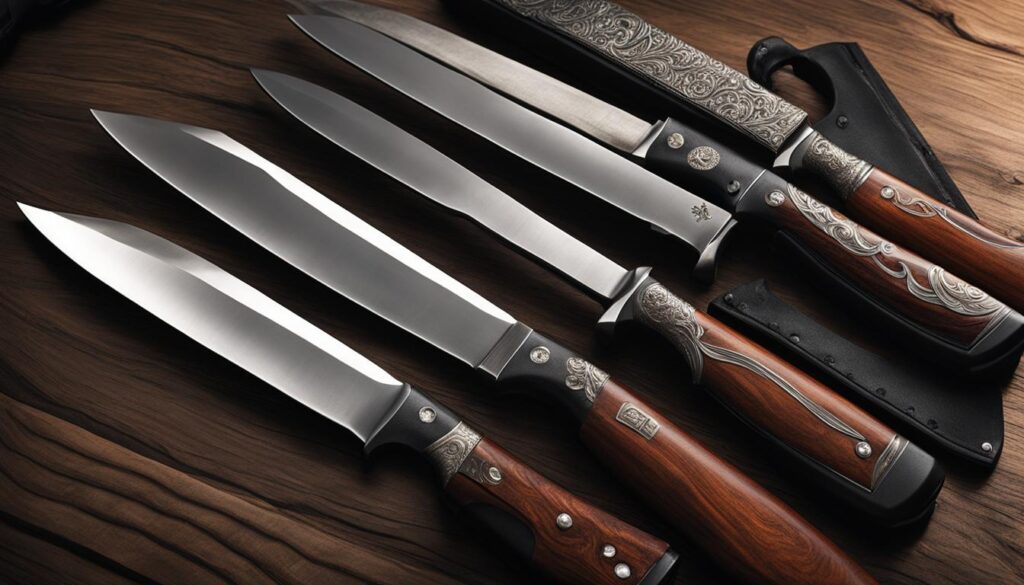

Conclusion
Mastering the art of sharpening hunting knives is a valuable skill for any hunter. It not only improves the efficiency and effectiveness of processing game but also promotes ethical hunting practices. By choosing the right hunting knife, using proper sharpening techniques, and investing in quality sharpening tools, hunters can ensure they have a razor-sharp hunting knife for their next adventure in the great outdoors.
FAQ
How often should I sharpen my hunting knife?
The frequency of sharpening your hunting knife depends on how often you use it and the type of game you are processing. As a general rule of thumb, it is recommended to sharpen your hunting knife after every few uses or whenever you notice a decrease in its cutting performance.
What angle should I hold the blade at when sharpening my hunting knife?
The angle at which you hold the blade while sharpening depends on personal preference and the type of knife. Generally, a 20 to 25-degree angle is suitable for most hunting knives. You can use a sharpening guide or practice maintaining a consistent angle by visually aligning the blade with the sharpening surface.
Can I use any type of sharpening stone for my hunting knife?
It is recommended to use sharpening stones specifically designed for hunting knives. Coarse stones (around 220 grit) are used to remove the dull edge, while finer stones (around 1000-6000 grit) refine the edge to a razor-sharp state. Using the appropriate grit for each stage of sharpening ensures optimal results.
How do I know if my hunting knife is properly sharpened?
To test the sharpness of your hunting knife, you can try slicing through a piece of paper or gently cutting through a hair. A properly sharpened knife will glide effortlessly through the material without any tearing or snagging. Remember to always exercise caution when performing these tests to prevent injury.
Can I sharpen my hunting knife in the field?
Yes, there are portable knife sharpeners available that are designed for field sharpening. These sharpeners, like the Off-Grid Knives EDC Knife Sharpener, are compact and easy to carry, allowing you to maintain your knife’s sharpness even when away from home. They are especially useful for outdoor enthusiasts who require on-the-go sharpening.
